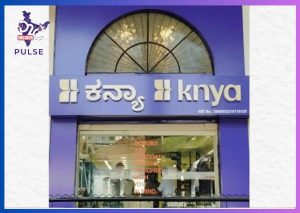The energy-efficient fan maker claims to be staring at a ₹1,000 crore revenue by the end of FY 2023-24, and bagged backing from Steadview Capital, and Temasek, among others, amid a tepid funding cycle.
But this validation for the brand has come after more than a decade of experimentation, frugality and evening coming very close to shutting down.

Atomberg currently is one of the most talked about small home appliance start-up in India. The firm is also probably the first player that has managed to disrupt an industry ruled by incumbent brands including Bajaj, Crompton and Havells.
The Mumbai-based firm’s differentiation? Its hero product, a fan that saves electricity and also looks pretty. This innovation– in an industry that has not seen much product development in over a decade– proved to be a crowd puller.
The fan-maker recently managed to bag $86 million from Steadview Capital, backer of Nykaa, Zetwerk and Lenskart, and Singapore-headquartered Temasek, among others.
But selling across India, penetrating through general trade stores, and getting monetary backers onboard has been decade-long arduous journey.
The early days
In 2012, Manoj Meena, a fresh graduate from Indian Institute of Technology (IIT), Bombay, decided to start an engineered product company with three other batchmates. A few product experimentations at the time included developing data acquisition system and vehicle training system.
But the products did not find a scalable market, and the initial batchmates moved on to other pursuits. Sibabrata (Shibam) Das, who was also Meena’s batchmate, then joined the firm in 2013 as co-founder and chief operating officer (COO).
“There was no Atomberg at the time. But there was a product-first thinking,”
Das told D2C Insider in an interaction.
By 2015 though, Meena had created a protype of a fan, which ran on BLDC (brushless direct current) motor, making the small appliance energy efficient. The firm also managed to raise ₹1 crore from Aarti Industries’ promoter family.
The challenge now was to find the right set of users, which took some time. “While saving electricity was a good value proposition, convincing regular consumers to buy our fans was difficult,” says Das.

Also, not many customers, back in 2015, were open to trying out new brands in the home appliance category. Only after the pandemic-led shopping boom, consumers across India are open to trying out brands they haven’t heard of before.
Atomberg’s energy-saving proposition did find takers though. Businesses and institutions—including schools and hospitals—that use fans in bulk were happy to reduce their electricity bill by ₹800-1,000 every year on every fan.
“The B2B segment worked well for us, and we were building with decent scale. But in order to build a scalable brand we had to sell to consumers,”
says Das.
Conversations with multiple interior designers and consumer feedback made it clear that a fan also needs to look nice, with minimal design, for consumers to want to pay a premium pricing.
Atomberg’s celiling fans currently start retailing from ₹2,899 and go up to ₹8,350. Incumbent brands including USHA and Havells’ also sell fans at similar or higher pricing depending upon the model. Technological extensions including remote control and voice activation was also added by Atomberg to their fans after getting more consumer feedback.
The brand then started by selling directly to consumers, in 2016, through their own website and marketplaces, and also raised ₹6.7 crore from Parampara Ventures in pre-series A round.
Runway reduction, brink of closure
Das claims the two funding rounds gave Atomberg a runway of about nine months, which was extended to about two years. The brand was also clocking up to ₹4 crore monthly average revenue in 2019, according to Arindam Paul, who became part of the founding team in 2015.
But while, Atomberg was generating revenue, it needed an urgent capital infusion to sustain this growth and accelerate offline expansion.
The founding team met with almost every investment firm across India, the US, and China, and Atomberg was not able to raise more funds. Sometimes even after getting term sheets.
Backing a product-based firm, big on hardware, is not an easy decision for investment firms.
“Building an appliance start-up requires a very strong product, longer growth time frame, expertise in expanding through physical channels, and a big chunk of capital,”
says an investor evaluating the appliance space, who wished to remain anonymous.
And in India, about 99 percent of the small appliances sell across general trade stores, including local hardware and electrical shops, which makes the market fragmented and difficult to crack.
While Atomberg had a differentiated product, the founding team was finding it difficult to convince investment firms about their physical expansion capabilities.
With less than a month of runway left Atomberg was on the brink of shutting down.
But the fan-maker’s journey was probably destined to continue. While being on the verge of giving up, Das saw a news notification about Sequoia Capital India’s (now Peak XV Partners) former managing director starting his own investment firm.
“Without any hopes, I wrote to Abhay Pandey on LinkedIn. And he responded. The firm gave us a term sheet within 10-15 days,”
Das says.
Pandey, with his former Sequoia Capital India’s managing directors—Gautam Mago and VT Bharadwaj– started A91 Partners in December 2018.
The investment firm led a $10 million Series A round, in January 2019, for Atomberg as Pandey had been impressed by the fan-makers journey.
Full steam offline expansion
“In the LinkedIn message Shibam mentioned the company’s revenue, and reviews on marketplaces. What Atomberg had achieved in 3 years was better than what I had expected and that really caught my attention,” says Pandey, who reviewed Atomberg in 2017 while at Sequoia. But did not back the firm then as the brand seemed really small.
During the due diligence, A91 Partners had found a brand that had very good reviews and sales through marketplaces, presence across stores retailing small appliances, and a team that knew how to expand offline.
With a much larger cash infusion, it was full steam ahead for Atomberg’s general trade expansion. The firm started by putting up their products across a few counters in Mumbai. Currently, the brand has presence across 700 counters in the city.
Atomberg also had consumer demand data by selling through digital channels, which showed a higher demand from Southern states including Kerala and Tamil Nadu.
“To increase our penetration, we started advertising in regional languages,”
says Paul.
The brand ran TV advertisements in Malayalam across Kerala, in 2020, which proved to be a fruitful in creating brand awareness.
Atomberg is currently selling all over India through online and physical retail, while entering newer geographies including Assam and West Bengal. With a quarterly average revenue of Rs 250 crore and presence across more than 20,000 stores—Atomberg plans on reaching 40,000 stores in the next 3-4 years.
The firm has also launched new categories including smart locks and kitchen appliances but does not expect revenue contribution from these categories anytime soon. “Every vertical takes its own sweet time to build up. It took us 5-6 years to build a stronghold in the fan space,” says Das.
Currently, India’s household appliance market amounts to $74.49 billion, according to research firm Statista. The market is expected to grow by 5.65 percent compounded annual growth rate (CAGR) until 2028.
While Atomberg does not face direct competition from start-ups in the fan category, it would face a heady competition from incumbents. “We are aware of the competition and the only way for us to differentiate is through our innovation. And that is what we are going to keep focusing on,” says Das.
As the firm aims to build for at least one more decade, the ups-and-downs of scaling a brand is not lost on Atomberg. But with a hero product and a few others in the pipeline, the brand has the potential to be at par with existing incumbent players.








